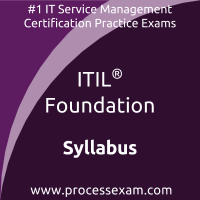
To achieve the professional designation of ITIL Foundation, candidates must clear the ITIL Foundation Exam with the minimum cut-off score. For those who wish to pass the ITIL Foundation certification exam with good percentage, please take a look at the following reference document detailing what should be included in ITIL Foundation Exam preparation.
The ITIL Foundation Exam Summary, Body of Knowledge (BOK) and Sample Question Bank, provide the basis for the real ITIL Foundation exam. If you have made this decision to become a certified professional, it is advisable to take authorized training and prepare with an online ITIL Foundation Practice Exam to achieve the best result. We have designed these resources to help you get ready to take ITIL Foundation exam.
ITIL Foundation Exam Summary:
| Exam Name | ITIL Foundation |
| Exam Code | ITIL Foundation |
| Exam Fee | USD $150 |
| Exam Duration | 60 Minutes |
| Number of Questions | 40 |
| Passing Score | 65% |
| Format | Multiple Choice |
| Sample Questions | ITIL Foundation Exam Sample Questions and Answers |
| Practice Exam | ITIL Foundation Practice Test |
ITIL Foundation Syllabus Topics:
| Unit | Content |
|---|---|
|
Service management as a practice |
The purpose of this unit is to help the candidate to define the concept of a service, and to comprehend and explain the concept of service management as a practice.
- Specifically, candidates must be able to:
|
|
The ITIL service lifecycle |
The purpose of this unit is to help the candidate to understand the value of the ITIL service lifecycle, how the processes integrate with each other, throughout the lifecycle and explain the objectives, scope and business value for each phase in the lifecycle.
|
|
Generic concepts and definitions |
The purpose of this unit is to help the candidate to define some of the key terminology and explain the key concepts of service management.
- Specifically, candidates must be able to define and explain the following key concepts:
|
|
Key principles and models |
The purpose of this unit is to help the candidate to comprehend and account for the key principles and models of service management and to balance some of the opposing forces within service management. Specifically, candidates must be able to:
Service strategy
- Describe value creation through services Service design - Understand the importance of people, processes, products and partners for service management - Understand the five major aspects of service design
Continual service improvement
- Explain the continual service improvement approach - Understand the role of measurement for continual service improvement and explain the following key elements:
|
|
Processes |
The purpose of this unit is to help the candidate understand how the service management processes contribute to the ITIL service lifecycle, to explain the purpose, objectives, scope, basic concepts, activities and interfaces for four of the core processes, and to state the purpose, objectives and scope for eighteen of the remaining processes.
The list of activities to be included from each process is the minimum required and should not be taken as an exhaustive list. Specifically, candidates must be able to:
Service strategy
- State the purpose, objectives and scope for: - Service portfolio management
- Financial management for IT services
- Business relationship management
Service design
- Explain the purpose, objectives, scope, basic concepts, process activities and interfaces for: - Service level management
- The following list must be covered:
- State the purpose, objectives and scope for:
- Service catalogue management - Availability management
- Information security management (ISM)
- Supplier management
- Capacity management
- IT service continuity management
- Design coordination
Service transition
- Explain the purpose, objectives, scope, basic concepts, process activities and interfaces for:
- Change management
- State the purpose, objectives and scope for:
- Release and deployment management
- Knowledge management
- Service asset and configuration management (SACM)
- Transition planning and support
Service operation
- Explain the purpose, objectives, scope, basic concepts, process activities and interfaces for:
- State the purpose, objectives and scope for:
Continual service improvement
- State the purpose, objectives and scope for:
|
|
Functions |
The purpose of this unit is to help the candidate to explain the role, objectives and organizational structures of the service desk function, and to state the role, objectives and overlap of three other functions.
Specifically, candidates must be able to:
- Explain the role, objectives and organizational structures for:
State the role and objectives of:
|
|
Roles |
The purpose of this unit is to help the candidate to account for and to be aware of the responsibilities of some of the key roles in service management.
Specifically, candidates must be able to:
- Account for the role and the responsibilities of the
- Recognize the responsible, accountable, consulted, informed (RACI) responsibility model and explain its role in determining organizational structure.
|
|
Technology and architecture |
The purpose of this unit is to help the candidate to:
- Understand how service automation assists with expediting service management processes
|
|
Competence and training |
- Competence and skills for service management
- Competence and skills framework
- Training
|
